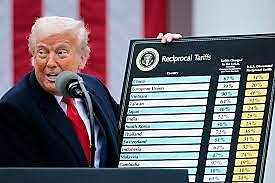As the Supreme Court prepares to hear arguments next week on President Trump’s global tariffs imposed under the International Emergency Economic Powers Act, administration officials have made a bold claim: striking down the tariffs would cripple the president’s ability to negotiate trade agreements. But America’s trade policy history reveals something different. As my Cato trade colleagues Scott Lincicome, Colin Grabow, and I argue in a recent amicus brief, the administration’s claims don’t withstand scrutiny.
Success Without IEEPA Tariffs
Since the IEEPA became law in 1977, the United States has successfully negotiated and implemented comprehensive trade agreements with countries around the world: 14 major free trade agreements (FTAs) with 20 countries (Figure 1), plus landmark multilateral deals like the Tokyo Round and the Uruguay Round, which converted the General Agreement on Tariffs and Trade into the World Trade Organization. The WTO now comprises 166 members, covering more than 98 percent of the global trade volume.
Not one of these agreements was completed with IEEPA tariffs being imposed or threatened. Even under the administration’s mercantilist logic about the superiority of exports to imports, these FTAs and multilateral agreements were a success: in virtually every agreement, our trading partners lowered their tariffs on American exports more than we reduced ours on their goods.
A Superior Approach
These trade deals negotiated without IEEPA tariffs are superior to IEEPA-based agreements in three important ways, as we explained in the brief:
First, they are more durable because they were entered into voluntarily by foreign governments, making these parties less likely to defect in the future. So too on the U.S. side; implementation of these agreements involved constitutional power-sharing—negotiated by the executive branch and codified by Congress—making them less vulnerable to reversal by a future executive than unilateral IEEPA deals. President Trump himself used the congressional-executive agreement process during his first term to negotiate and implement the U.S.–Mexico–Canada Agreement.[1]
Second, previous U.S. trade agreements are more comprehensive than the 2025 IEEPA-related trade deals. Prior to 2025, the typical U.S. trade agreement contained more than a dozen chapters on not just trade in goods but also services, investment, and, in recent years, e‑commerce. Past U.S. FTAs also contained detailed disciplines on tariffs, non-tariff measures, customs rules, and other measures that can affect trade flows as much or more than tariffs. The IEEPA deals, by contrast, are much simpler and narrower (and more ambiguous).[2]
Third, because of their firm and comprehensive foundation, past U.S. trade agreements generally enhanced trade.[3] The United States International Trade Commission has found, for example, that U.S. bilateral and regional trade agreements resulted in a significant increase in exports to and imports from FTA partner countries (and thus an increase in U.S. trade overall).[4] The Chamber of Commerce adds that U.S. exports to FTA partners grew nearly three times faster than U.S. exports worldwide over the same period.[5] It is unlikely the IEEPA trade deals will have similar effects, especially as they lock in U.S. tariffs at historically high levels.
Table 1 shows the impact of US FTAs on US trade:
America’s True Bargaining Power
The United States’ true negotiating strength doesn’t come from tariffs and the threat thereof. Instead, what has historically made the United States an attractive trading partner stems from a massive, dynamic economy, technological prowess and leadership, and stable legal institutions. These assets make other countries eager to negotiate with the United States. In fact, the Trump administration’s erratic and coercive trade policies are undermining these longstanding assets.
Even accepting the premise that tariffs are useful bargaining chips, there is still no need to invoke IEEPA. Congress has already granted the executive branch clear authority to impose tariffs for various policy objectives. High-ranking Trump administration officials acknowledge as much, and President Trump himself has claimed to have used such authorities during his first term to negotiate deals with Japan and China.
Simply put, the evidence doesn’t support the administration’s claims that IEEPA tariffs are essential to the president’s ability to negotiate trade agreements. In fact, history very much suggests the opposite.
[1] Christopher A. Casey & Cathleen D. Cimino-Isaacs, Trade Promotion Authority (TPA), Cong. Research Serv. (Feb. 20, 2024), https://www.congress.gov/crs-product/IF10038; Shayerah I. Akhtar, U.S.–UK Trade Relations: Background and Select Issues, Cong. Research Serv. (July 25, 2025), https://www.congress.gov/crs-product/IF11123; Liana Wong & Lauren Ploch Blanchard, U.S.–Kenya Trade Negotiations, Cong. Research Serv. (May 22, 2024), https://www.congress.gov/crs_external_products/IF/PDF/IF11526/IF11526.6.pdf.
[2] See, for instance, Exec. Order 14,345 on the framework negotiated with Japan, The White House, Implementing the United States–Japan Agreement (Sept. 4, 2025) (published at 90 Fed. Reg. 43535), https://www.whitehouse.gov/presidential-actions/2025/09/implementing-the-united-states-japan-agreement/ and the Joint Statement on a United States–European Union Framework on an Agreement on Reciprocal, Fair, and Balanced Trade (Aug. 21, 2025), https://www.whitehouse.gov/briefings-statements/2025/08/joint-statement-on-a-united-states-european-union-framework-on-an-agreement-on-reciprocal-fair-and-balanced-trade/. By contrast, the United States–Mexico–Canada Agreement and the U.S.–Korea Free Trade Agreement contain binding disciplines on issues such as customs administration, sanitary and phytosanitary measures, rules of origin, and electronic commerce, as well as impartial, state-to-state dispute settlement measures. Office of the United States Trade Representative, Agreement between the United States of America, the United Mexican States, and Canada Text (Jul. 1, 2020), https://ustr.gov/trade-agreements/free-trade-agreements/united-states-mexico-canada-agreement/agreement-between and KORUS FTA Final Text (Jan. 1, 2019), https://ustr.gov/trade-agreements/free-trade-agreements/korus-fta/final-text.
[3] As a result of expanded trade, previous U.S. FTAs and the GATT/WTO agreements yielded positive economic gains. A 2021 United States International Trade Commission report found that U.S. trade agreements implemented since 1984 increased US GDP by nearly $90 billion and increased domestic employment by about 485,000. U.S. Int’l Trade Comm’n, Economic Impact of Trade Agreements Implemented under Trade Authorities Procedures, 2021 Report 89, https://www.usitc.gov/publications/332/pub5199.pdf.
[4] See id. at 98. (finding that U.S. exports to FTA partners increased 12.9 percent more than a counterfactual scenario where no FTAs are in place, and that US imports from FTA partners increased by 15.2 percent versus the same counterfactual. The analysis does not include the Uruguay Round Agreements.
[5] U.S. Chamber of Commerce, The Open Door of Trade: The Impressive Benefits of America’s Free Trade Agreements, https://web.archive.org/web/20210223080246/https:/www.uschamber.com/sites/default/files/open_door_trade_report.pdf.

